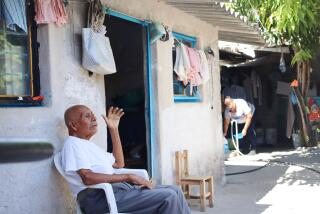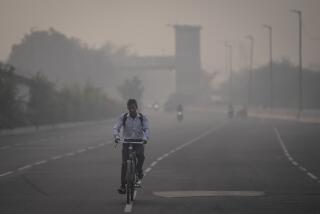In Niger, Hunger Hits Crisis Level
The frail baby boy she cradles has arms no thicker than her finger. His belly has hollowed and his skin has sagged as his weight has dropped.
Rakiya Nassirou weeps constantly over her son, wondering what is happening to him and whether God is angry with her. But 6-month-old Rabiou is not her only worry. Another boy, 3-year-old Moussa, is with her at this feeding station run by Doctors Without Borders. Nassirou left four more children and her sick husband back home in their village two weeks ago with no food.
The aid agencies now scrambling to save these children say it didn’t have to be this way.
In the best of circumstances, they acknowledge, hunger shadows Niger and its neighbors along the southern edge of the Sahara desert. Malnutrition, malaria, diarrhea and other ills kill one in four children before the age of 5.
But last fall, things got much worse. The rains didn’t come. Then the locusts, the worst infestation in 15 years, arrived.
A United Nations appeal in November for help for Niger was all but ignored. Another appeal in March for $16 million resulted in about $1 million in contributions. Even as world attention was focused on Africa last month at a Group of 8 summit of the world’s richest nations, little happened. Niger was offered debt forgiveness, but nothing was done about the hunger issue.
The crisis underscores one of the long-standing problems faced by international relief agencies. It is much easier to raise money once starvation has set in and children are dying than to prod donors to head off a looming crisis.
Now, the World Food Program estimates 2.5 million of Niger’s nearly 12 million people are at risk of hunger; 1.6 million of them need immediate help. And the crisis is spreading. An additional 1.5 million people in neighboring Mali, Mauritania and Burkino Faso need food aid.
Only recent television footage of starving children has started making a difference.
“We are going into the worst period of the year, in the coming four to five weeks, with the rainy period and diarrhea. And this is the last month before the harvest, meaning there are few food stocks and they are running very low,” said Johanne Sekkenes, head of mission at Doctors Without Borders in Niamey, Niger’s capital.
Doctors Without Borders is admitting nearly 1,300 children a week to its emergency feeding program in the Maradi region, 340 miles east of Niamey. The numbers are still rising.
The group has treated almost 15,000 severely malnourished children since January, 5% of whom died. According to UNICEF, 192,000 malnourished children in Niger need help, 32,000 of whom are severely malnourished and facing death.
Niger is nearly three times the size of California, but two-thirds of it is desert and only 15% of the land is suitable for farming. It is regarded as the second-poorest country on Earth, ahead only of Sierra Leone, another western African country.
Most of the population depends on herding and subsistence agriculture. It rarely raises a blip on the radar of international affairs. The last time it made headlines was before the Iraq war, when reports surfaced that uranium yellow cake from Niger had found its way to Saddam Hussein. The report turned out to be false.
Women often bear the brunt of Niger’s crises, since many men travel to neighboring countries for work, often for years at a time.
Nassirou fears that the revolving cycle of hunger is not the result of fickle rains, but the wrath of God.
“Maybe God curses us,” she said. “God blames us.”
“I hope God will give us life and health and take us out of this poverty.”
Lying on a blanket at the feeding center, she said, “I cry because I cannot understand what is happening to my son. I cry because I don’t know what to do. I have been crying ever since I got here.
“I’ll do anything for him to get better,” she said, gazing down at her baby with melting eyes. “There’s nothing more precious than a child.”
Dr. Chantal Umutoni, in the intensive care unit at the feeding station, said she was sad and angry over the delayed international response.
“Maybe those lives could have been saved,” she said.
A starving boy named Mamane Sani Abdou, 13 months, was admitted to the feeding program Thursday, a frail, listless child with starkly protruding ribs and stick-like limbs that were limp. His mother, Babi Abdou, 20, fed him a few spoonfuls of enriched milk, which he coughed up before sagging back, panting desperately from the effort.
“Before, he used to drink a whole cup of milk,” said Abdou, who said her boy first fell ill after being circumcised two months ago. She spent all her savings, about $12, first on traditional medicine and then Western medication.
A child in similar condition, 16-month-old Saidou Saiman, came into intensive care at 11 a.m. Wednesday, “too sick to even make a sound,” Umutoni said. Just after midday, his heart failed. He was resuscitated but died about 4 p.m.
His mother composed herself and took her child home for burial.
“She was trying to be strong,” the doctor said.
In another part of the ward, Tchima Mamane gently kissed her son’s stomach, hoping that 2-year-old Rashid, severely malnourished and ill for three months, would recover. But doctors said they were unsure whether he would survive, especially after such a long period of sickness. Rashid’s brother Halilou, died in 2003 when he was 2.
Rashid has not smiled for almost three weeks.
“I’ll be happy the day he smiles because then I’ll know he is better,” his mother said. She appealed for the world to send food to help her child and others regain their health.
The food crisis extends well beyond Maradi.
On Wednesday, Fatu Haliss tried to spoon-feed her son, Alassan, but the 1-year-old cried and spat out his food. The boy’s head is reduced to a bony skull and his face is gaunt, his eyes large and round. He weighs about 7 pounds, about half a pound less than about two weeks ago, when he arrived at a feeding center in Tahoua, 230 miles northeast of Niamey.
Haliss’ family provides a bitter example of Niger’s poverty. The woman’s parents are dead. She has not heard from her husband since he left to work in neighboring Libya more than a year ago.
Two of her children were stillborn. Four others “died normally,” as she put it. Four are alive, including Alassan, “the thinnest child I ever had.”
“Many small children died in our village,” she said.
She spent the last of her money on half a bag of rice, which she left with her other children when she brought Alassan to the feeding center, and fears it may have run out by now. Worse, her crop needs tending, or it could fail.
“I have nobody at home. My husband left, and I have to work in the field. I need to get back home. I have nothing else to eat, only my crop. It could die and then who will feed me? I have nobody to feed me.”
For Umutoni, it is tough watching these children, who arrive only when they are near death.
“Children who are very sick and malnourished are often very quiet. But when you start to nourish them, they start to make more noise. Their eyes become more lively, and shining,” she said. “You see life in their eyes.”
More to Read
Start your day right
Sign up for Essential California for news, features and recommendations from the L.A. Times and beyond in your inbox six days a week.
You may occasionally receive promotional content from the Los Angeles Times.






